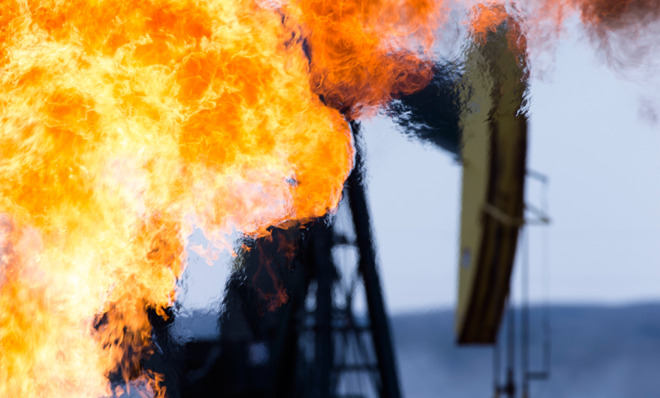More proof that fracking is dirtier than advertised
But regulation to prevent methane leaks may be easier than you think


I've written before about the biggest problem when it comes to fracking and climate change: methane leaks. Natural gas is a much cleaner fuel than coal, which theoretically could be useful in cleansing our electricity generation system of the worst pollutants, even if natural gas is not nearly enough by itself to stop climate change. But because it is a much more powerful greenhouse gas than carbon dioxide over the short term, the release of methane could cancel out any benefits natural gas might provide.
A new study is the latest to confirm that view. Absent regulation, fracking could very well be a net negative when it comes to climate change. But there are some new wrinkles to the story that suggest preventative regulation could be cheaper and easier than we think.
The Week
Escape your echo chamber. Get the facts behind the news, plus analysis from multiple perspectives.

Sign up for The Week's Free Newsletters
From our morning news briefing to a weekly Good News Newsletter, get the best of The Week delivered directly to your inbox.
From our morning news briefing to a weekly Good News Newsletter, get the best of The Week delivered directly to your inbox.
During two days of intensive airborne measurements, oil and gas operations in Colorado's Front Range leaked nearly three times as much methane, a greenhouse gas, as predicted based on inventory estimates, and seven times as much benzene, a regulated air toxic. Emissions of other chemicals that contribute to summertime ozone pollution were about twice as high as estimates, according to the new paper, accepted for publication in the American Geophysical Union's Journal of Geophysical Research: Atmospheres. [CIRES]
What does this mean? First of all, there are two ways of measuring such leaks. The EPA has based its leak estimates by examining samples at every point in the production process (the drill, the well head, the pipelines, etc.), and then adding up what they found. That's what "inventory" refers to.
This study, by contrast, flew a plane over the extraction sites and measured the difference between upwind and downwind methane levels, thereby measuring leaks from every source in an entire area. They found, in concert with previous measurements, that leaks were much higher than the EPA method would suggest.
I spoke to the Environmental Defense Fund's* chief scientist Steven Hamburg, who calls these two methods the "bottom-up" and "top-down" approaches. He emphasizes that both are necessary to provide a complete picture of the emissions situation. The EPA's bottom-up approach may not be enough to get a complete picture, but it will be necessary to figure out where the leaks are happening and plug them.
So where are the leaks? Without more research it's hard to say for sure, but he suspects they may come from a tiny minority of "super emitters" that are leaking vastly more than everyone else. If true, this would explain why the EPA's estimate came in low, since you would need a very large sample size to capture a small minority of huge emitters. It would also fit with other pollution profiles, like that of cars, in which a tiny fraction of vehicles are responsible for the preponderance of emissions.
A free daily email with the biggest news stories of the day – and the best features from TheWeek.com
If this speculation is correct, then the solution is obvious: Just imitate those states that test for annual emissions to make sure no car is an egregious polluter. In this case, EPA folks will have to go well to well and make sure every drilling operation is within tight limits.
The upside is that the vast majority of operations likely will already be in compliance, so they won't have to do any expensive upgrading. Only a small minority will have to refit and retool. That would be nearly painless, so fingers crossed.
Hamburg says that there are several more studies on methane leaks that will be released throughout the year. I'll be keeping a close eye on them as they're released. Watch this space.
*Full disclosure: The EDF partially paid for this study, which was carried out by an independent research team.
Ryan Cooper is a national correspondent at TheWeek.com. His work has appeared in the Washington Monthly, The New Republic, and the Washington Post.
-
 Bengal Tiger at the Baghdad Zoo: ‘funny, profound, must-see theatre’
Bengal Tiger at the Baghdad Zoo: ‘funny, profound, must-see theatre’The Week Recommends Rajiv Joseph’s ‘engrossing’ tragi-comedy about the absurdities of war
-
 Magazine solutions - December 19, 2025
Magazine solutions - December 19, 2025Puzzles and Quizzes Issue - December 19, 2025
-
 How weight-loss jabs are changing the way we eat
How weight-loss jabs are changing the way we eatIn The Spotlight Anti-obesity drugs have been a boon for Babybel but are supermarkets ready for a slimmed-down Christmas?
-
 Has Zohran Mamdani shown the Democrats how to win again?
Has Zohran Mamdani shown the Democrats how to win again?Today’s Big Question New York City mayoral election touted as victory for left-wing populists but moderate centrist wins elsewhere present more complex path for Democratic Party
-
 Millions turn out for anti-Trump ‘No Kings’ rallies
Millions turn out for anti-Trump ‘No Kings’ ralliesSpeed Read An estimated 7 million people participated, 2 million more than at the first ‘No Kings’ protest in June
-
 Ghislaine Maxwell: angling for a Trump pardon
Ghislaine Maxwell: angling for a Trump pardonTalking Point Convicted sex trafficker's testimony could shed new light on president's links to Jeffrey Epstein
-
 The last words and final moments of 40 presidents
The last words and final moments of 40 presidentsThe Explainer Some are eloquent quotes worthy of the holders of the highest office in the nation, and others... aren't
-
 The JFK files: the truth at last?
The JFK files: the truth at last?In The Spotlight More than 64,000 previously classified documents relating the 1963 assassination of John F. Kennedy have been released by the Trump administration
-
 'Seriously, not literally': how should the world take Donald Trump?
'Seriously, not literally': how should the world take Donald Trump?Today's big question White House rhetoric and reality look likely to become increasingly blurred
-
 Will Trump's 'madman' strategy pay off?
Will Trump's 'madman' strategy pay off?Today's Big Question Incoming US president likes to seem unpredictable but, this time round, world leaders could be wise to his playbook
-
 Democrats vs. Republicans: who are US billionaires backing?
Democrats vs. Republicans: who are US billionaires backing?The Explainer Younger tech titans join 'boys' club throwing money and support' behind President Trump, while older plutocrats quietly rebuke new administration
